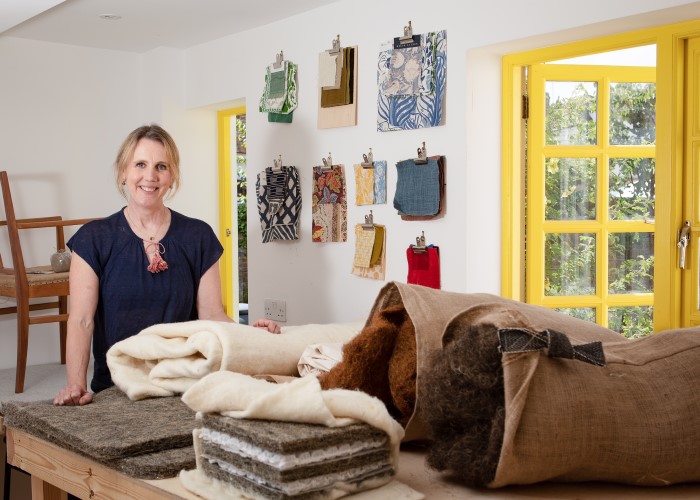Toxic chemical fire retardants: What’s new?
Back in February, we took a look at some of the concerns being raised around chemical fire retardants in upholstered products. What’s happened since?

The Furniture and Furnishings (Fire Safety) Regulations 1988 covers the requirements on manufacturers for testing and labelling of domestic furniture. Currently, this means that to meet the requirements of the open flame and smouldering testing, manufacturers are generally using chemical fire retardants. Experts including upholsterers, manufacturers, and the Fire Brigades Union (FBU) are raising concerns about the impact of these chemicals on the quality of our air and our health/wellbeing.
Mathew Freeman, Past President of the British Institute of Interior Design, has been involved in the work to change the regulations, signing the Fidra consensus statement in September on behalf of the BIID. Fidra are an environmental charity using scientific evidence to achieve positive environmental change with evidence-based solutions. In addition to working with Fidra, Mathew has also been working with the furniture Committee.
“During the consultation period I joined the British Standards FW/6 Flammability performance and fire tests for furniture Committee, representing the BIID. The committee is responsible for the development and maintenance of British Standards relating to flammability of furniture, which I am very privileged and excited about joining during this key moment in the new regulation and standards’ history, ” explains Mathew.

Delyth Fetherston-Dilke of Delyth Upholstery Richmond has also been a leading voice on this issue and at a recent panel at Decorex explained the scope and importance of the issue:
“We’re talking about over 1000 studies that are all linking the flame retardants that are put into furniture with toxic effects…As designers, your design is three dimensional and clean air is a really important part of your design. We can’t just look at the positive space. We have to look at the negative space as well.”
Many who have raised concerns have been quick to point out that the current regulations may not actually result in an improvement in fire safety, despite the potential harm they cause, as noted by Delyth at the panel.
“(Upholsterers) get rashes all over your hands when you work with top fabric. It’s not just the foam that the chemicals are put into, they’re put into the top fabric and each of the layers underneath it. There’s significant research currently showing that they don’t actually create any meaningful fire safety and the worry about them is that as they burn they release hydrogen cyanide and carbon monoxide. Lancaster University, which is one of our preeminent fire science universities, has released a report showing that flame retardants increase smoke toxicity more than they reduce fire growth rate. The Fire Brigade Union is concerned that chemical flame retardants offer negligible delay to fire ignition and worsen fire conditions.“
Speaking to the BIID, Delyth adds that “fire safety is really important, and there are many practical steps we should as a country be taking - detailed studies lay out these recommendations for the Government, yet they are being overlooked as the Government continues its focus on chemical flame retardants that are not safe in our homes, not safe as they burn and not safe in our environment.“

The materials we use can have a positive impact with natural materials such as wool, jute, coir and horsehair being inherently less flammable, but Delyth identifies a change in regulations as being a significant part of the challenge and, speaking to the BIID, added:
“Back in 2019, there was an environmental audit committee analysis of toxic chemicals in every day life. That was our government deciding that we should move to the US / EU model, and ensure that the top fabric is so tightly woven that for 45 minutes a burning cigarette won’t get through. That’s what they have in America, and that’s what the environmental audit committee recommended we move to, and that’s not what we’ve got in the new draft regulations”.
So, what now? Mathew Freeman will continue to update the BIID on progress:
“The development of the new standards in support of Furniture and Furnishings (Fire) (Safety) Regulations will be discussed and agreed by the committee, so I can ensure members that I will be working hard on helping to define the new approach to the fire safety of domestic upholstered furniture. The amount of information submitted during the consultation will determine the next steps, and I we will keep members informed of progress.”
The BIID will continue to update on any changes affecting the industry. Sign up to the newsletter to keep up to date on this and other topics.
For further information, you can watch the full panel from Decorex here and follow Delyth’s campaigning on her Instagram @delythfd
Explore new resources from the BIID. Seeing a padlock? Just login or become a member to view.
View the highlights from our 60th anniversary party
We asked Anna Burles: What makes the perfect software?
Discover the smart home technology awards with Platinum Partner, CEDIA
Explore the latest, member-exclusive, templates designed to make your life easier.
University of Gloucestershire wins the BIID Student Design Challenge 2025.





